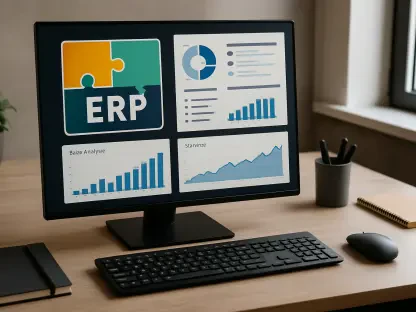Setting the Stage for Cloud Database Evolution
In an era where digital transformation dictates business success, the cloud database market stands as a critical battleground for innovation, with global spending on database-as-a-service (DBaaS) solutions projected to grow at a compound annual rate of over 15% from now to 2027. Amid this rapid expansion, MariaDB, a prominent player in open-source relational database management systems, has made a seismic move by reacquiring SkySQL, a cloud-native DBaaS platform it had previously spun off. This strategic decision, announced under new leadership, rebrands SkySQL as the core of MariaDB Cloud, aiming to deliver fully managed services, serverless scalability, and advanced AI capabilities. This market analysis dives into the implications of this acquisition, examining how it reshapes MariaDB’s competitive stance, aligns with prevailing industry trends, and forecasts its potential impact on enterprise adoption of cloud database solutions. The focus here is to unpack the data, trends, and projections that define this pivotal moment in the database sector.
Deep Dive into Market Trends and Strategic Analysis
Cloud Adoption Driving Database Innovation
The database market is undergoing a profound shift, with cloud-native solutions becoming the backbone of enterprise IT strategies. Industry reports indicate that over 60% of businesses have migrated at least half of their database workloads to the cloud, driven by the need for scalability, cost efficiency, and reduced operational complexity. MariaDB’s reacquisition of SkySQL taps directly into this trend, positioning the company to cater to organizations seeking seamless transitions to cloud environments. By reintegrating a platform specifically designed for managed services, MariaDB addresses a clear demand for DBaaS offerings that minimize IT overhead while maximizing flexibility, a move that could accelerate adoption among mid-sized enterprises hesitant about cloud complexities.
This trend is further fueled by the increasing reliance on multi-cloud architectures to avoid vendor lock-in, a concern for nearly 70% of IT decision-makers according to recent surveys. MariaDB Cloud, with its support for major providers like AWS, Google Cloud, and Azure across more than 40 regions, offers a compelling solution to this challenge. However, the market remains fiercely competitive, with hyperscalers dominating through integrated ecosystems. MariaDB’s challenge lies in differentiating its open-source heritage and hybrid deployment options as unique value propositions in a landscape crowded with proprietary giants.
Technological Advancements Shaping Competitive Edges
Beyond adoption trends, technological innovation is a key driver reshaping the database market, with serverless computing and AI integration emerging as game-changers. MariaDB Cloud introduces serverless, pay-as-you-go pricing models alongside high-availability clusters, catering to diverse workload demands with cost-effective scalability. More notably, the platform’s incorporation of agentic AI—systems capable of autonomous database management and elastic scaling—positions it at the forefront of a niche yet growing segment. Market projections suggest that AI-driven database solutions could account for a significant share of DBaaS growth by 2027, as businesses seek automated tools to handle dynamic data environments.
Despite the promise, integrating such advanced features comes with hurdles. Industry insights highlight concerns over governance, particularly the risk of uncontrolled compute costs stemming from autonomous AI operations. MariaDB must navigate these challenges by establishing robust oversight mechanisms to ensure that innovation does not compromise cost predictability. If successful, this technological edge could redefine market expectations, pushing competitors to accelerate their own AI and serverless offerings, thereby intensifying the race for technological supremacy in the DBaaS arena.
Competitive Landscape and Market Positioning
Analyzing MariaDB’s position within the competitive landscape reveals both opportunities and risks following the SkySQL reacquisition. The database market is dominated by hyperscalers whose vast resources and integrated services often overshadow smaller players. Yet, MariaDB’s focus on open-source principles and multi-cloud flexibility offers a distinct alternative for enterprises wary of proprietary lock-in. Analysts note that this strategic pivot stabilizes the company’s cloud roadmap, providing clarity to customers who may have been uncertain about prior directional shifts, potentially increasing trust among risk-averse sectors like finance and healthcare.
Geographically, the platform’s wide regional availability aligns with stringent data residency regulations, a critical factor in markets such as Europe where compliance drives technology choices. Still, lingering perceptions about open-source solutions lacking enterprise-grade robustness pose a barrier. MariaDB’s ability to educate the market on its hybrid and cloud capabilities will be crucial in converting skeptics into adopters. As competition tightens, this acquisition could serve as a catalyst for carving out a niche among businesses prioritizing flexibility over brand dominance, though sustained marketing and innovation are essential to maintain momentum.
Forecasting the Future of Cloud Database Solutions
Looking toward the horizon, several trends are poised to shape the trajectory of the cloud database market, with MariaDB’s latest move serving as a microcosm of broader shifts. The demand for fully managed services is expected to surge as organizations continue to prioritize operational simplicity, with projections indicating that DBaaS could dominate over 50% of database deployments within the next few years. This aligns seamlessly with MariaDB Cloud’s offerings, suggesting strong growth potential if execution remains consistent. Additionally, economic pressures are likely to boost adoption of cost-efficient, pay-as-you-go models, a space where MariaDB’s serverless options hold significant promise.
Another pivotal trend is the rise of agentic AI, forecasted to become a standard feature in database management by the end of this decade. This technology’s ability to autonomously adapt to workload changes could transform how enterprises manage data, though governance challenges remain a wildcard. Regulatory landscapes around data privacy are also evolving, amplifying the need for multi-cloud strategies that MariaDB is well-equipped to address. If the company can balance innovation with compliance and cost control, it stands to gain a substantial foothold among forward-thinking enterprises, potentially influencing market standards for AI integration and cloud flexibility.
Reflecting on Strategic Pathways Forward
Looking back, the analysis of MariaDB’s reacquisition of SkySQL underscored a calculated response to escalating market demands for cloud-native database solutions. It highlighted how the integration of cutting-edge technologies like serverless scalability and agentic AI had positioned the company to meet emerging enterprise needs. The competitive and regulatory insights further emphasized the delicate balance MariaDB had to strike to differentiate itself in a hyperscaler-dominated field.
Moving forward, strategic recommendations for stakeholders included prioritizing robust governance frameworks to manage AI-driven operations, ensuring cost predictability for users. Businesses evaluating database vendors were advised to consider multi-cloud capabilities as a hedge against vendor lock-in, using MariaDB’s model as a benchmark. For MariaDB itself, investing in market education to dispel myths about open-source limitations emerged as a vital step to broaden adoption. These actionable insights aimed to guide decision-makers in navigating the evolving cloud database landscape, leveraging this acquisition as a springboard for sustained growth and innovation.








